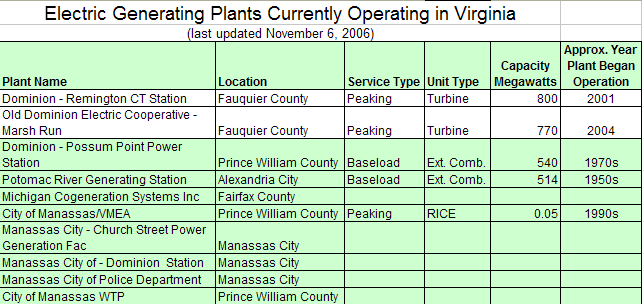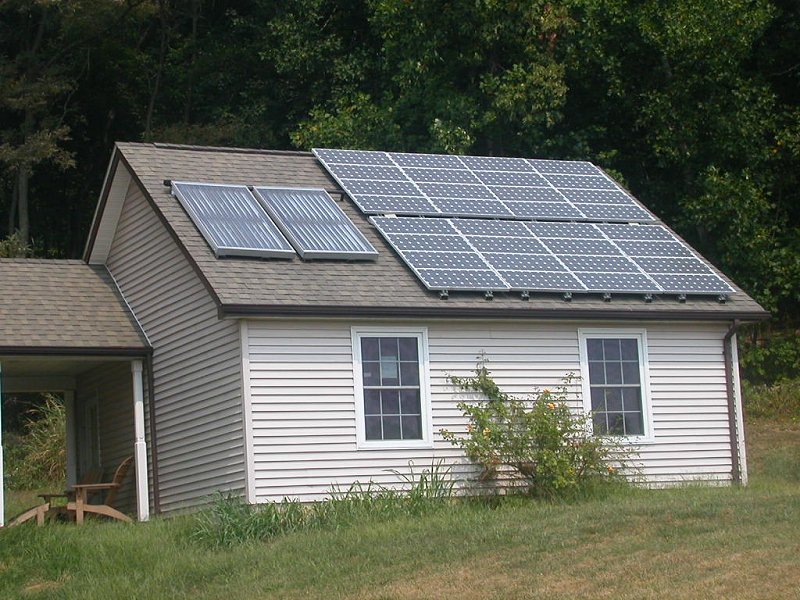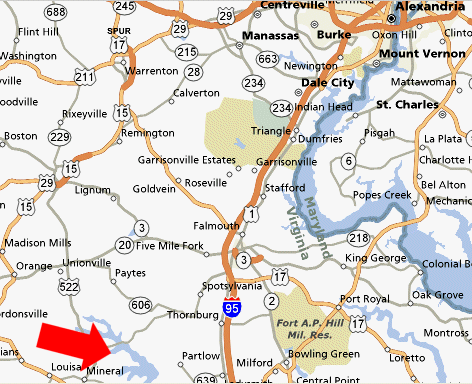
in 2006, the Potomac River Generating Station was still operating in Alexandria
Source: Virginia Department of Environmental Quality (DEQ)

in 2006, the Potomac River Generating Station was still operating in Alexandria
Source: Virginia Department of Environmental Quality (DEQ)
Northern Virginia has industrial sites as well as office buildings, shopping centers, software companies and coffee shops. Two major electricity generating plants were built in Alexandria and Dumfries after World War II. Both used coal initially, and that source of fuel was used at the Potomac River Generating Station in Alexandria until the plant closed down. The coal-burning facilities at the Possum Point Generating Facility in Dumfries were replaced by gas turbines to reduce emissions and meet air quality mandates.
Both were constructed in the late 1940's as the population in the region boomed and electrical appliances became popular. Both plants were located on the river's edge, because massive amounts of water were required for cooling. Power plants burn fuel to generate steam that spins generators, and that steam must be cooled in order to be recycled through the plant again. The vapor leaving a nuclear power plant cooling tower is steam condensing as it cools.
The Alexandria plant was owned by the Maryland utility PEPCO until the Maryland General Assembly deregulated electricity generation. PEPCO then sold the plant to a private "merchant" firm that had no retail customers, Mirant. PEPCO bet that it could acquire power cheaper than it could generate it, and Mirant bet that it could generate and sell power at a profit.
The old power plant was the source of major controversy, and the City of Alexandria tried to force its closure. City residents had concerns about health effects from the plant's emissions, particularly mercury. That element, a minor component in coal, is vaporized in the burning process. As hot exhaust cools in the air after leaving the power plant's smokestacks, a plume of emissions moved over Alexandria and then to the northeast (typically). Mercury cooling from the exhaust gas was deposited near the plant, creating a "hot spot" of potentially-toxic soil in the local area.
Alexandria officials tried to get state officials to force the power plant to close because of air quality concerns, and also tried an innovative use of local zoning authority. The plant was constructed before the city created its first zoning ordinance, so use of the site for a power plant was "vested" or "grandfathered in" when the zoining ordinance was passed. A retroactive application of zoning that would have forced the plant to close would be a "taking" under the Fifth Amendment. The city tried a creative approach. It claimed the plant's violation of a Special Use Permit (SUP), which had been granted later by the city, entitled Alexandria to revoke all permissions for operating the entire plant.
The Virginia Supreme Court rejected this effort. The ruling provided perspective on why an industrial use that was acceptable 50 years ago had become a problem for the city (emphasis added):1
Mirant, which was later named NRG/Gen-On, shut down the outdated power plant in 2012. Alexandria completed the Old Town North Small Area Plan in 2017, anticipating conversion of the industrial site to a mixed use community on the waterfront. . In Northern Virginia, solar power is the most likely potential source of decentralized, renewable energy production. Cost of installing solar panels is the primary deterrent, on rooftops that receive sufficient sunlight throughout the day.
Few homeowners are likely to invest up to 20,000 to eliminate air leaks and add solar panels if the savings in energy costs amount to just a few hundred dollars annually. The benefits begin to match the costs, in pure financial terms, when the government establishes tax subsidies or utilities raise costs. The sun provides free energy, but capturing that energy and converting it to electricity requires an up-front investment in solar infrastructure.

solar cells in Loudoun County
Wind energy is a potential source, but projects are proposed for ridgetops or out in the ocean. Northern Virginia is unlikely to attract investment in wind energy funding unless small units attached to individual structures become cost-effective.

Source: Wind Energy Resource Atlas of the United States (the potential in Northern Virginia is very low)
There are no nuclear power plants in Northern Virginia. However, just outside the Northern Virginia region is the North Anna nuclear power plant. Dominion Energy plans to expand it from two to four reactors. The third reactor would be a conventional one, and the fourth unit would be a small modular reactor.
In addition, a nuclear plant at Calvert Cliffs, Maryland is located near the Cove Point liquified natural vas facility. A resident there, when asked if the community was concerned about the co-location of the two facilities, reportedly commented that it did not matter to the locals what would happen to the nuclear plant if the LNG facility exploded... because no one would be left to care.

Location of North Anna Nuclear Power Plant
Source: Mapquest
Power plants fueled by coal and nuclear are massive and very expensive facilities. They generate baseload power, supplying the steady minimum demand throught the 24-hour day. Twice a day, at breakfast time and dinner time, demand peaks as people get ready to go to work/school or return from work/school. It is not cost-effective to build massive coal and nuclear plants that run for only a portion of the day
Since the 1990's utilities have constructed primarily natural gas "peaking plants" that can run for just the hours of peak demand. The City of Manassas built such a plant in 1990 along the railroad tracks near Wellington Road. It is invisible to almost everyone, but helps reduce the cost of electricity. Manassas buys power wholesale from Dominion Resources, then retails electricity to city residents as a government-provided service. The wholesale contract "incentivizes" the city to avoid purchasing power at "peak" times, such as late afternoons in August when air conditioning systems are running full blast. Dominion structured the contract so the utility would not have to construct new generating plants for just short-term power demand.
The City of Manassas has an air quality permit to run its natural gas-fired generators on Wellington for a small percentage of the year, but the city gains a substantial reduction in the cost for electricity by supplying its own electricity during times of peak demand. As a member of the Virginia Municipal Electric Association, the city is also exploring becoming an investor in a $1 billion coal-fired electric power generating plant in Wise County (in Southwest Virginia).
The cost of land for energy facilities is low outside the region, and the cost of transmission is low, but additional power plant has just been proposed for Gainesville. On March 18, 2008, the Washington Examiner revealed that LS Power is considering building a new power plant near Gainesville, and the Prince William Board of County Supervisors has granted a 3-year option for the company to purchase the county's mulch-production site on Balls Ford Road.
Does Prince William need a new power plant? At Possum Point near Dumfries, Dominion Power can generate "1,630 megawatts, or enough electricity to power 407,500 houses at peak demand" according to a Dominion spokesperson.2 There are 135,000 housing units in Prince William now, so the county is exporting power. A new powerline will enable Possum Point to send more electricity to Delaware/New Jersey/New York.
That means Prince William County is already absorbing the impact of generating power for others, but getting tax revenue in exchange. A gas-fired plant would generate far less pollution that the coal-fired plant now operating in Alexandria.